
(Jan. 2005) NICOLAS CHEVREUX started out in the review business with a website
known as Totentanz, graduated to the Recycle Your Ears webzine and
then became a label owner. The label is Ad Noiseam and, over the last
four years, Nicolas has been discovering amazing new acts, designing
exotic and engaging packaging, and consistently delivering material
that caters to only one rule: it has to turn his head. For those of
us in the trenches, fighting to find good music among all the dreck
which washes over the walls, Nicolas is a rock to which we can all
gravitate. His taste never wavers and his catalog at Ad Noiseam is
never anything less than fascinating, weird, fantastic, and moving.
The beauty of Ad Noiseam is that Nicolas continues to challenge
himself with what he listens to and what he offers as releases on the
label. You can’t pigeon-hole the Ad Noiseam sound; you can only chase
after it.
::..:::…..:..::….:::::..:::..:::::::……:::…::.:::….::::..:..:::…::…….::::
Igloo :: Is breakbeat the new shit? How would you describe the appeal
of the broken beat to someone who might be coming to your label from a
different genre?
Nicolas :: I wouldn’t necessarily say that breakbeat is the new shit.
Classic forms of this genre tend to be just as boring and talent-less
as anything else. On the other hand, I think that some of the most
interesting releases and artists in electronic music are using
breakbeat structures and influences. It is nothing really new, but the
most innovative and daring records are coming these days from people
influenced by this genre. Better said, while I enjoy Boards of Canada
as much as Squarepusher, people into Squarepusher seems overall more
interesting at the moment than people following the path of Boards of
Canada. It was not always the case, and it will change, though.

A way to describe the appeal of broken structures is maybe to point
out how limited most electronic music genres are. Every style has its
boundaries and rules, from trance to drum’n’bass, from what’s
generally called IDM to gabber. In this sense, I don’t know if Ad
Noiseam is really about break beats, but certainly about combining or
escaping these restrictions, hence ending up in dealing with patterns
that might sound “broken” or uncommon.
Igloo :: Your catalogue is extremely eclectic and seems to be beholden
only to your tastes rather than any definitive marketing plan. What
are the pros and cons with this approach when it comes to marketing
and expanding your listening base?
Nicolas :: Somehow, everything has already been done as far as
electronic music is concerned. From maximalist noise to the most
stripped down tones, from the coldest and bleakest approach to the
warmest and most lyrical one, there is no room left for absolute
innovation. If you add to this that each sound already have a
multitude of labels and artists dedicated to one specific line, it
would sound vain, pretentious and pointless to bring to any genre yet
another label.
In this case, I believe that one can stay enthusiastic and, hopefully,
interesting only by following one’s own tastes. This is why, to a
major extent, my choices regarding Ad Noiseam are dictated only by
what I personally enjoy. I have, of course, to take into account
whether or not a sound or a band can really be brought towards an
audience, and whether or not Ad Noiseam is able to do so. But the
first question is “do I like this?” and the second “can it work?”, not
the other way round. It would be possible to focus Ad Noiseam on a
very precise direction and audience. Some people work this way, and do
it well. I however think that I would get bored if I was to follow
this path, and I would rapidly lose any enthusiasm in the label. I
think that having an eclectic catalog is a lot more rewarding, both
for me, for the artists and for the audience.
Igloo :: Is there value in niche markets? Would your inclination be to
reiterate the core sound of a niche or to try to break it open to
other sounds?
Nicolas :: Niche markets are interesting because they mean a group of
people who are easy to reach and to please. Once you have hit a trend
or a scene, you can very easily spread your music, and you will get
constant feedback. People in these subgroups are the one who dance the
most and applause the most, they bring a lot of energy to artists and
labels. On the other hand, if you only deal with small scenes and
repeat a sound ad vitam aeternam, you’ll probably become tired
of it and lose the reasons why you started your label or your band in
the first place. It’s clearly harder, but also more philanthropic and
appealing to bring the sound from a scene to other people, or a new
sound to an old scene.
Igloo :: What’s the biggest hurdle a label has to overcome in order to
find an audience? Is it better to sell them on one release (or one
style of record) or on the label as an on-going source of material?
Nicolas :: It’s probably not better, but it is a lot easier to get
people to appreciate a release or an artist than a whole label.
Except for music reviewers, nobody gets quickly a clear idea of what a
label is about. Somebody will purchase a release from a label such as
Ad Noiseam, and associate this label with the sound on this precise
record. Now, the label can then offer the same sound again on another
release, and be sure to appeal to the fans of this sound, or it can
try something different, keep the quality control high, and hope that
your audience will also like the second (but different sounding)
record. A label owner can get a faithful fan base a lot faster by
staying in one genre, but he also takes the risk of loosing his whole
audience very fast when the trend dies.
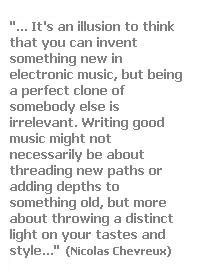
Igloo :: As a label owner, what are your inspirations? What do you
look to for your inspiration (beyond music even)?
Nicolas :: This is really hard to say. I am really fond of movies and
literature, but I don’t know if my taste in these fields is reflected
in any way on the music-related choice I make for the label. I would
be hard pressed to put a link between an artist on Ad Noiseam and a
film or a book that I like.
Igloo :: Is music always about finding something new or hearing a
unique take on some sound or is there room in our lives for listening
to something old and familiar and finding greater depth in it?
Nicolas :: If music was only about being innovative, there wouldn’t
have been any record put out in the last 20 years. You don’t need to
be totally new to be interesting, but you still have to instill a
personal side in your art to be exciting. It’s an illusion to think
that you can invent something new in electronic music, but being a
perfect clone of somebody else is irrelevant. Writing good music might
not necessarily be about threading new paths or adding depths to
something old, but more about throwing a distinct light on your tastes
and style.
Igloo :: Ad Noiseam also runs a mail order that is specifically
tailored to “things Nicolas likes.” Is this an extension of the label
and does the combination of the two equal your efforts at sharing your
personal musical tastes?
Nicolas :: The mail order was created out of dire need. As a young
label, it’s a lot easier to sell not only Ad Noiseam releases, but
also records from other people. And, plainly said, it is the only way
for a small label such as Ad Noiseam to survive. It’s a lot of
repetitive work, though, and I am not sure that I would actually have
a mail order if I did not need it. The question of what is sold in the
Ad Noiseam mail order is basically the same as the one about the
releases. It takes some effort to buy, promote and sell a record from
another label, and I might as well work only with music that I enjoy
spreading. This is valid only to a certain extent, as there is music I
like which would not have any place in the Ad Noiseam mail order. But
on the other hand, offering the Ad Noiseam records in the middle of a
catalog of music I don’t esteem would be a disservice to the releases
I want to push.
Igloo :: How vital is it for the public to have agents like yourself
that they can trust to find them interesting content?
Nicolas :: Not vital enough, or everything would be a lot smoother, I
guess. Joke aside, I find it exciting to go to a record store and get
a recommendation for something I have never heard of. And everybody
who is into non-mainstream music was introduced to it somehow (via a
friend, a DJ, a radio show, a store), so I guess that it is important
to have people who can help. There is probably no shortage of people
of the kind, though.
[An aside by the interviewer as both a reviewer and a
professional-grade music junkie: I find it vitally important to have
filters out there — agents whose taste I know to be solid and good.
Nicolas is one of my secret virtual record store clerks who always has
something great to recommend. His mail order selection consistently
highlights the gems of the smaller, less distributed labels.]
Igloo :: How global are your ears?
Nicolas :: Not global enough. I try to listen to a lot of things, but I
am totally uneducated as far as certain styles are concerned. It is
more a matter of time and chance than of anything else, though. I am
more closed to things I do not like anymore than to things I do not
know yet.
Igloo :: You do a lot of the design work on the releases and they are
as diverse as the music. How critical is a design that matches the
sound for a record?

Nicolas :: As far as people who still go shopping for music in stores
are concerned, the design and layout are the first things they are
confronted with. In this sense, it’s important to communicate a
feeling of the record with its artwork. Moreover, having a nice CD or
record makes the music sound better. One enjoys a lot more listening
to an album which is nicely presented than to one which looks
uninteresting, no matter how it sounds. You cannot disassociate the
music from the physical medium that carries it, and the artwork is one
of the elements of creating a richer experience.
Igloo :: It’s the Christmas season. What would be the best Christmas
present the label could receive this year?
Nicolas :: It might seem very pessimistic, but the best thing that a
label can get, besides huge sales, is feedback. Contrary to a band,
which performs live and gets reaction from its audience, somebody
working for a label often get neither praise nor loathing. Adding to
this that a label’s aim is not to promote itself, but to support the
work of somebody else, the best thing that a label manager can get is
a word of appreciation or encouragement. A label such as Ad Noiseam
doesn’t run on money, but on the idea that there is somebody out there
who cares.
::..:::…..:..::….:::::..:::..:::::::……:::…::.:::….::::..:..:::…::…….::::
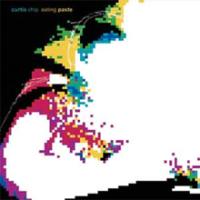
As co-founder of Zod Records, Curtis Chip’s vision of epileptic
breakbeats can be heard throughout the label’s releases and in his own
Eating Paste 12″ release. Ad Noiseam’s re-issue of this 12″ as a CD
collects the tracks from the vinyl, adds a few, and rounds it all out
with a series of remixes by Larvae, Enduser, Binray, Eight Frozen
Modules, Ove Naxx, Xanopticon and Tarmvred. It is, essentially, chaos
and more chaos. Though danceable.
8-bit melodies whistle past hammered synthesizers while Mandelbrotian
breakbeats are thrashed past their elastic limits. “That’s Not It At
All” revs like an engine being redlined and the resultant clatter is
every moving part under the hood shearing loose in a free-for-all auto
part collision while the radio chirps an 8-bit pastoral of diode
happiness. Tarmvred’s remix of the same (the “that’s not Curtis Chip
at all” remix) reminds me why I love Jonas’ work so much: equal parts
squalid noise and 8-bit fury fuse together to create a virtual
hurricane of sound. The discordant faces of “Happy Days” (the light
tone poem and the fractious beat disintegration) get disparate
emphasis in the respective remixes by Enduser and Ove Naxx: Enduser
opts to highlight the light-hearted elements and downplay the
fragmented programming while Ove Naxx cranks up the distortion and
drowns the innocence in a pool of howling static.
Eating Paste is what I imagine the rush would be like from ingesting
the glue from childhood: funny tasty, kinda gritty, and bound to make
your head spin and your pulse race. Curtis Chip’s mad dash
programming requires a hardy constitution to enjoy and his tightly
programmed brand of anarchy is whiplash listening. Wear pads when you
crank this one.
::..:::…..:..::….:::::..:::..:::::::……:::…::.:::….::::..:..:::…::…….::::
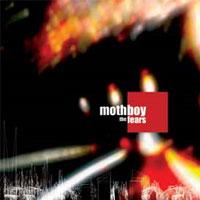
Simon Smerdon doesn’t care much for the phrase “dark hop” so I’ll use
it once and set it aside. Born from the “dark hop” aesthetic (two
records as Ocosi with Scorn and Horchata providing support), Smerdon’s
Mothboy project looks beyond the basic monstrous ambience and
sub-sonic tectonic upheaval that keeps dark hop in the basement and
seeks to give the sound enough spiteful energy and chaotic movement
that it can climb out of the sub-cellars and get into the walls of the
upper floors. His latest release, The Fears, is a beat-heavy affair,
cut with orchestral flourishes and party-music insouciance, that seeks
equal ass wiggle time with its spinal chill and chest paralyzing
thrill.
Smerdon has described the perfect record as being an equal split
between live instrumentation and electronics. “Stuck in a Moment”
combines a live jazz quartet with glitch and ambience. A
collaboration with monster beat master Larvae, “Stuck in a Moment”
wiggles like a be-bop dancer filled with electrons, electric light
glowing through her half-closed eyelids and syncopated drum loops
rattling through her loose joints. “We Don’t Ride with Vampyres”
begins with a scratchy 78 recording of an old organ-grinder’s theme
music before descending into a nightmarish ride through doom-laden
landscapes. “Folk,” a brief diversion halfway through the record,
plays out with drum kit and a series of processed mandolins and guitar
sounds as a reflective back porch jam session.
There are subterranean rumbles here as well; don’t think that Smerdon
has forsaken the sub-sonic aesthetic. There’s the relentless and dark
atmosphere of “Don’t Ride With Vampyres” while “Spiders” thrashes like
a broken toy with lives wires jutting out of its cracked cranium.
“Becoming Solar” skitters between slow magma movement and
knife-sharpening breakbeats. Smerdon’s real accomplishment with The
Fears is cracking open the “dark hop” sound and welding its sonic
thunder to a cocktail-hour jazz aesthetic and a frenetic after-hour
underground club vibe. The Fears takes what it wants and doesn’t look
back. This is an assured debut that thumbs its nose at us as it goes
to new places.
::..:::…..:..::….:::::..:::..:::::::……:::…::.:::….::::..:..:::…::…….::::
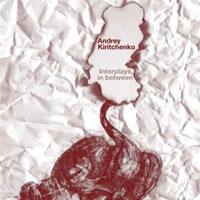
Following his first full-length CD (Kniga Skazok on Ad Noiseam),
Andrey Kiritchenko went on the road and played nearly every music
festival in Eastern Europe, attempting to bring attention to the
vibrant music scene in the Ukraine. Having collaborated during this
period with a number of luminaries in the Western world of click,
glitch and micro-pop, Kiritchenko returns with Interplays, In Between,
an evolution from the fairy tale theater of his first release.
Interplays, In Between finds Kiritchenko experimenting with organic
warmth — adding ambient tones, field recordings, stringed instruments
and gently distorted voices to his digitally precise sonic adventures.
The ambient sounds of “Bits Colashade” evolve over time into a street
recording of a busy intersection while in the foreground tiny granules
of electronic detritus pop and crackle. “Rush To Take Hot Bath” is
sine wave drones against a shimmering field of energized particles, a
shower of electrons pinging all radar screens with near white noise
intensity. “Textile Heart” is like a thick wool curtain, colorfully
knit so that it is like wrapping sunlight around you and all the tiny
brittle hairs of the wool fiber tickle your skin. “Kingdom of Blessed
Dream” loops like a Pole experiment with a stately pace and tiny
scattered incoherence. “Army of Drums and Strings” hums with an
approaching swarm of cicadas while a buried sump pump chugs and
gurgles in the foreground.
The tracks of Interplay, In Between are more loop-based than his
previous record and the repetitive rhythms are reminiscent of the
micro-rhythms coming out Germany. Kiritchenko’s additional elements
are fine granular glitch, tiny bursts of sound and noise that become
music over the looping, echoing rhythms and the hushed field
recordings and ambient tonal washes. More actively melodic than Pole
and less trance-inducing than minimal techno, Interplay, In Between
floats in its own space, replete with liquid depth and crackling fire. Oddly warm and organic for such a technically exacting record.
::..:::…..:..::….:::::..:::..:::::::……:::…::.:::….::::..:..:::…::…….::::
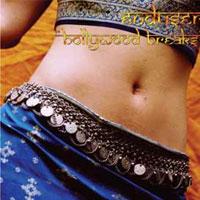
Never one to stand still, Lynn Standafer (a.k.a. Enduser) has moved on
from the rolling ganga smoke of a Jamaican head shop to the thick
incense of a Hindi temple for his latest release, Bollywood Breaks. A
12″ best served from the DJ turntable, Bollywood Breaks is Standafer’s
homage to the bhangra music of the Hindi film industry as seen through
his lens of brutal breaks and infectious beats. From the siren
explosion of “Not So Distant Drums” to the Technicolor washes of sound
and voices in “No Wisdom” to the tabla and sitar infused “Not Here,”
Standafer squeezes the Bollywood sound until it breaks and scatters
the head, heart and belly of India across his frenzied and seductively
danceable beats. Coupled with B-side remixes by Mad e.p., Larvae and
Line47, Bollywood Breaks is a highly contagious floor-burner of a
record that will melt your turntable. Short, sharp, and on my Best Of
list for 2004.
::..:::…..:..::….:::::..:::..:::::::……:::…::.:::….::::..:..:::…::…….::::
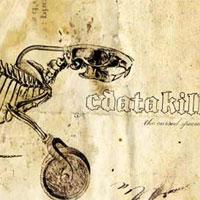
Zak Roberts aka Cdatakill says about the thought process that
germinated his second full-length release, The Cursed Species, that he
wanted to reclaim old school sounds, to make them his own and retrieve
them from the tyranny of “happy hardcore.” Harder, faster, louder
than Paradise, his previous Ad Noiseam release, The Cursed Species
eschews atmosphere and noise for the giddy power of the dance floor,
redrafting the euphoria of rave parties and endless disco nights into
a menacing 21st century beat explosion.
The nearly ten minute centerpiece of the record, “Reclamation Song,”
takes the rave aesthetic — endless rhythms running straight through
till dawn — and twists it into a knot of Gordian pulses as broken
beats and staggered percussion eat themselves in a continual
generative loop while miasmas of menace drift through like clouds of
burning poison. “Graceless” slashes through a spoken word
transmission, a radio signal that is cut and sliced by the digital
hammer of breakcore, smashing the vocal line into an unintelligible
patter that loses its linguistic impact and becomes just a rhythmic
sequence. “Hymn of the Siamese” slams a gabber rhythm into a crowded
room of innocent ravers while “Swarm of Vicious Insects” builds from a
chaste bell tone and piano melody into a stomping, snarling soundtrack
for an insect plague, replete with strangled air raid sirens, subsonic
rumbles from giant wings, and pestilential eruptions of percussion.
By the time “A Death Worth Reliving” finishes its calamitous
disintegration of your speaker system (opening a hole in your floor
straight down to Hell, naturally enough), this party has been turned
into a stroboscopic nightmare of epileptic fits and grand mal
seizures. And I say that like a good thing.
::..:::…..:..::….:::::..:::..:::::::……:::…::.:::….::::..:..:::…::…….::::
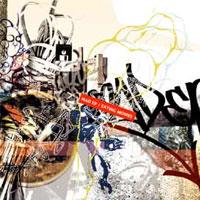
The cover of Mad e.p.’s first full-length release is a montage of
colored pencil sketches, graffiti, movie stills and granulated
textures. It’s a physical representation of the aural collage that is
Eating Movies. Swinging from the placid ambience of “Sail On” (music
for the afternoons when there isn’t a ripple on the lake) to the
abrasive hip-hop backdrop for MC Equivalent’s verbal bards on
“S-Cents” and “Den-M” to the chamber orchestra and DJ performance on
the elevated train of “Ride_072902”, Matthew Peters demonstrates that
he’s not tied to anything but a need for experimentation.
“Scab Removal Technique” utilizes Peters’ classical background with a
swell of strings that wash over an echoing bass drum, static whistles,
and a hollow drum kit that spasms in fifteen second spurts. “Get with
Rats” winds up to a noisy clatter, a blast of steam over a bed of
insane machinery — pistons and pinions furiously banging away —
while a delicate tabla dances just out of reach. Nicolas Major
provides Spanish guitar for “PMoonV2” while DJ Auracle’s cuts chatter
over a reverberant bed of subsonic tones. “Dweller,” with its field
recording from a back alley in NYC, plays out like a David Holmes
track done on the wrong side of town: sinister downtempo that oozes
menace while posturing to a Upper West Side address it can’t really
afford.
The press release uses the phrase “insolent talent” to describe
Peters’ work as Mad e.p. and it suits the slouching, dissipated
Generation Next attitude of the record, but it obscures the obsessive
attention to detail which makes the tracks work as layered abstract
electronica. Eating Movies isn’t an Attention Deficit Disorder
record; it’s just that Mad e.p. has a lot of things to say and many
ways he can express himself.
::..:::…..:..::….:::::..:::..:::::::……:::…::.:::….::::..:..:::…::…….::::
All releases above are out now on Ad Noiseam.











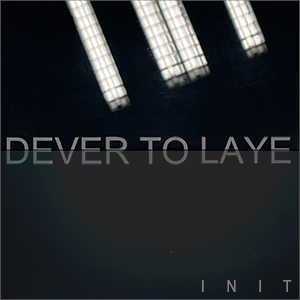






![Allmanna Town :: 1911 EP (Self Released) — [concise]](https://igloomag.com/wp/wp-content/uploads/2025/03/allmannatown-1911_feat2-75x75.jpg)



